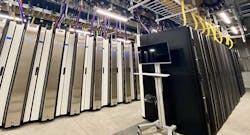How a Sustainability Focus Can Impact Power and Connectivity Choices
Last week we continued an article series on the role that sustainability should play in the development and deployment of data centers. This week, we explore how a sustainability focus might impact your choices around power and connectivity.
Get the full report
Are there different choices to be made when focusing on sustainability in site selection? The answer is, perhaps. The choices that need to be made are the same as those for any traditional data center site, but with a focus on building a sustainable data center from the site up. So let’s look at how a sustainability focus will impact your choices around power.
Power
Regardless of the energy efficiency you can achieve in your data center, a reliable power source is an absolute requirement. With a focus on delivering a carbon-neutral data center, hyperscalers have invested in carbon credits, purchasing them to offset the energy generated to run their facility and its workloads. This methodology simplifies carbon neutrality but isn’t the same as building a data center with a sustainable power source or sources. Concerns about the cost of power are fundamentally the same for a sustainability-focused data center as for a traditional one. Still, a commitment to sustainable infrastructure may give you more flexibility about the cost of power.
There are five types of renewable energy recognized as such by the US government:
- Hydropower
- Geothermal
- Solar
- Wind
- Biomass
Hydropower and Geothermal
Of these five types of renewable energy, only the first two, hydropower and geothermal, are both wholly sustainable and capable of meeting a data center’s power needs. Like any of these solutions, being able to provide 100 percent of your needed power with these methods is dependent on the location of your data center site. While there is hydropower available in most locations or power providers who purchase their energy from hydropower sources, being able to specify a renewable energy source is not something possible in every location. Geothermal is available in only a small number of sites as a primary power source but is readily available in countries such as Iceland and New Zealand, which, as small island nations, mean that the transmission costs throughout the country are also kept low. While the US is the leader in geothermal power generation, led by California and Hawaii, it is not readily available as you move east of Utah.
Solar and Wind
Both solar and wind are used to supplement energy production as renewable sources. Selecting energy providers who support or operate these renewable technologies can improve the overall sustainability rating of your data center.
Solar has now had years of development, and the history of environmentally dangerous byproducts from the production process is successfully being addressed.
Wind can be a very cost-effective method of power generation if properly implemented. Solar has now had years of development, and the history of environmentally dangerous byproducts from the production process is successfully being addressed. The intermittency issues with both solar and wind are being mitigated by advances in battery technologies, with current batteries based on lithium-ion and LiFePO4 manufacturing processes addressing many of the issues that the many versions of lead-acid batteries in use have been unable to address.
Biomass
Biomass energy production at scale is primarily performed via trash to steam plants where garbage is used to generate power. According to the EIA, roughly
13.5 billion kilowatt hours of energy were generated by these facilities last year. While there are locations where this type of power is easily found and used by data center operators, there are fewer than 80 such facilities in the US, with the number slowly getting smaller as they are phased out.
Connectivity
There are few, if any, special considerations that need to be made for connectivity in a well-selected sustainable data center site. Like any data center, the more options for connectivity, the better. Unless being purpose-built for a specific type of connectivity, your site should allow you to be carrier- neutral with multiple ways to get fiber installed. The availability of dark fiber can also be a plus, further expanding the range of options to data center users.
Download the entire paper, “Sustainability in Data Center Site Selection“ courtesy of Nautilus Data Technologies, to learn more. In our next article, we’ll explore how a sustainability focus will impact your choices around cooling, environmental impact, and your long-term prospects.
About the Author



